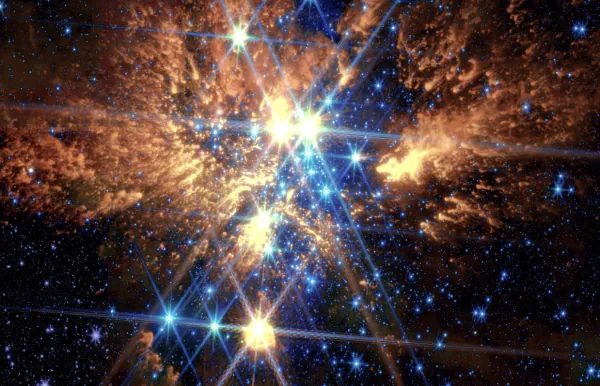
A Dazzling Cosmic Fireworks Display: Astronomers Study Westerlund 1 Star Cluster
2025-01-14
Author: John Tan
Introduction
In a groundbreaking revelation, astronomers have showcased an extraordinary cosmic fireworks display, capturing the turbulent interactions of stars within the super star cluster Westerlund 1. This electrifying event, fueled by the intense stellar winds, offers a crucial window into understanding the formation of massive stars and their profound impact on the surrounding cosmic environment.
Observations with NASA's James Webb Space Telescope
Using NASA’s advanced James Webb Space Telescope (JWST), researchers focused on Westerlund 1, located approximately 12,000 light-years away in the Milky Way galaxy. The cluster contains hundreds of massive young stars, some with masses up to 100 times that of our Sun, alongside potentially thousands of lower-mass stars.
Stunning Visuals and Dynamic Interactions
The latest images from JWST's Mid-Infrared Instrument (MIRI) have unveiled stunning visuals of evolved massive stars shrouded in bright, wispy structures shedding their outer layers. These stellar winds are not only visually striking but reveal a surprising variety of shapes and forms, indicating dynamic interactions between the stars and the extensive gas cloud surrounding them. This research ignites new questions about how mass loss and energy from massive stars influence star formation and the evolution of their environments.
Key Insights from Researchers
Kristina Monsch, an astronomer from the Center for Astrophysics | Harvard & Smithsonian, noted, “We were astonished to observe such diverse wind structures in Westerlund 1. We initially thought that the overwhelming stellar radiation would sweep away the gas and dust. The abundance of dust suggests that massive stars play a critical role in shaping their environment and might even influence star formation processes, similar to the ones happening around our Sun.”
Scientific Importance of Westerlund 1
Westerlund 1 holds immense scientific value as one of the nearest and most massive star-forming clusters. Unlike lower-mass stars, which live for billions of years, these massive stars have a short, intense life span of a few million years, rapidly depleting their hydrogen fuel and ejecting material through strong stellar winds and explosive outbursts—effects that are now observable in infrared wavelengths thanks to JWST.
Rare Insights and Future Predictions
Notably, Mario Guarcello from the INAF - Astronomical Observatory of Palermo emphasizes that although supermassive star clusters like Westerlund 1 are rare in today’s galaxy, they were once prevalent in the early universe. "Westerlund 1 serves as a prime testbed for expanding our understanding of the formation of massive stars amidst explosive conditions,” he remarked, drawing captivating parallels to awe-inspiring cosmic explosions.
Transformations Leading to Supernovae
As massive stars morph into supernovae—an event marked by dazzling displays of light—their transformations enrich their surroundings, eventually leaving behind neutron stars or black holes. To date, only one supernova has been recorded in Westerlund 1, but astronomers predict over 1,500 explosions over the next few tens of millions of years.
Observational Efforts and Findings
The extensive observational effort, detailed in the data-analytical work led by astronomers such as Kristina Monsch and Joshua Bennett Lovell, required a significant time investment, with the researchers staring at the star cluster for over six hours. Their perseverance paid off, revealing a treasure trove of winds and material ejecting from these massive stars, crucial for understanding their local environment's dynamics.
Future Research and Significance
Furthermore, Juan Rafael Martínez-Galarza noted the potential to assess the lowest mass stars in the cluster, paving the way for a more refined understanding of star formation.
Conclusion and Implications
This groundbreaking research was unveiled at the annual winter meeting of the American Astronomical Society (AAS) in National Harbor, Maryland, and is set to be published in the prominent journal Astronomy & Astrophysics. These findings are part of the Extended Westerlund 1 and 2 Open Clusters Survey (EWOCS), an international initiative aimed at unraveling the mysteries surrounding star and planet formation within these compelling super star clusters using the pioneering capabilities of JWST and NASA’s Chandra X-ray Observatory.
As scientists continue to unlock the secrets of Westerlund 1, the stars reveal not just their beauty, but crucial insights into the cosmic ballet that governs our universe. Are you ready to dive deeper into this stellar spectacle?
 Brasil (PT)
Brasil (PT)
 Canada (EN)
Canada (EN)
 Chile (ES)
Chile (ES)
 Česko (CS)
Česko (CS)
 대한민국 (KO)
대한민국 (KO)
 España (ES)
España (ES)
 France (FR)
France (FR)
 Hong Kong (EN)
Hong Kong (EN)
 Italia (IT)
Italia (IT)
 日本 (JA)
日本 (JA)
 Magyarország (HU)
Magyarország (HU)
 Norge (NO)
Norge (NO)
 Polska (PL)
Polska (PL)
 Schweiz (DE)
Schweiz (DE)
 Singapore (EN)
Singapore (EN)
 Sverige (SV)
Sverige (SV)
 Suomi (FI)
Suomi (FI)
 Türkiye (TR)
Türkiye (TR)
 الإمارات العربية المتحدة (AR)
الإمارات العربية المتحدة (AR)